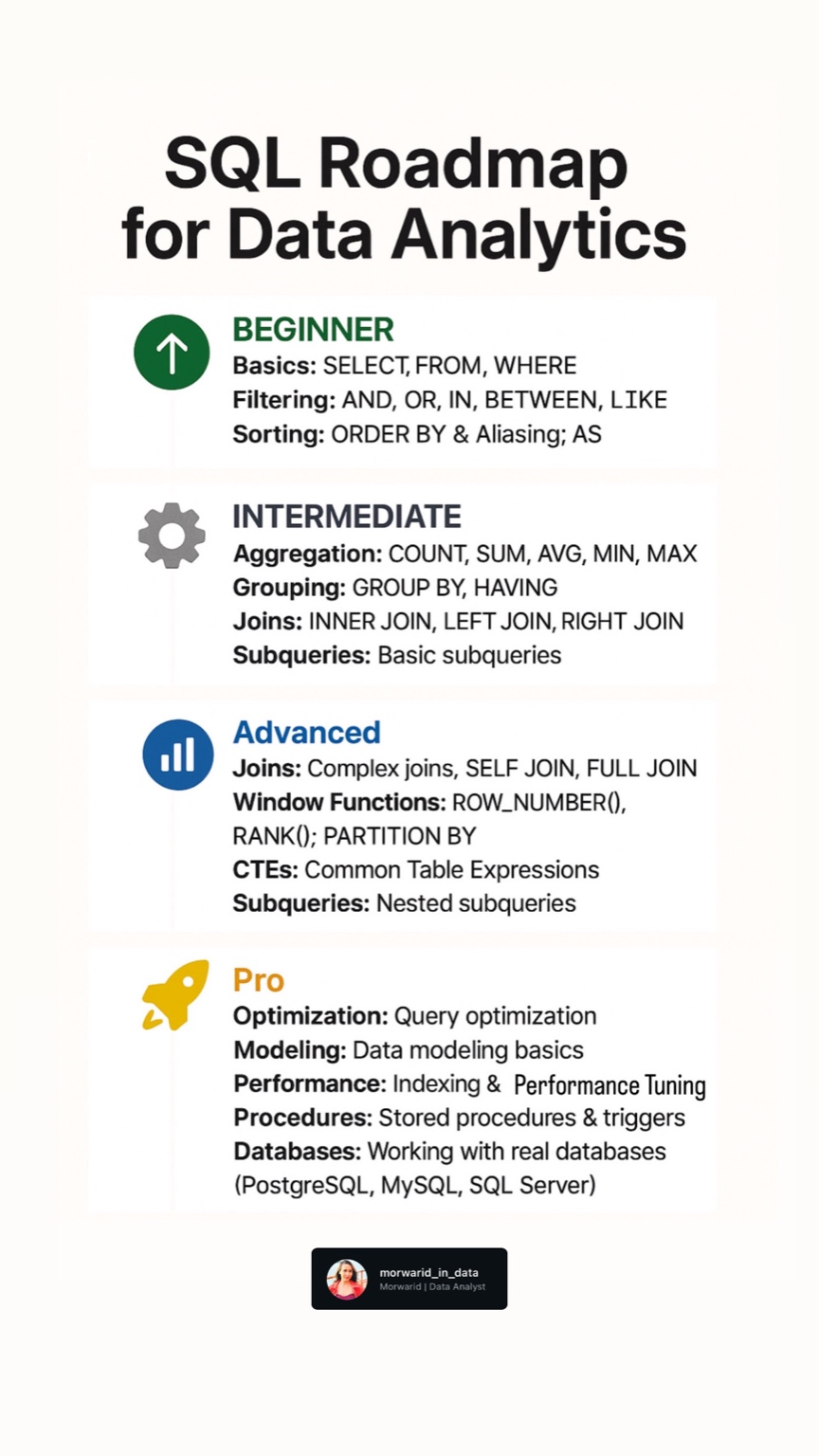
Welcome to Phase 3 of your data journey! In this module, you’ll learn Structured Query Language (SQL) — a must-have skill for querying, analyzing, and managing relational databases.
Whether you’re extracting customer behavior data or building automated reports, SQL is the language that brings your data to life.
1️⃣ SQL Basics
Start with the essentials of querying a relational database.
- 🏗️ What is SQL? Introduction to relational databases & SQL structure
- 📥 SELECT Statements – Extract columns from tables
- 🧮 Filtering – Use
WHEREclauses for targeted results - 📊 Aggregation –
GROUP BYandHAVINGto summarize data - 🔢 Sorting & Limiting –
ORDER BYandLIMITto control output - 🧠 Conditional Logic – Use
CASEstatements for if/then logic
💡 Think of SQL as asking structured questions to your database and getting specific answers.
2️⃣ Working with Multiple Tables
Real-world data is spread across multiple tables. Here’s how to combine it effectively:
- 🔗 Relationships: Understand One-to-One, One-to-Many, and Many-to-Many relationships
- 🤝 JOINs: Master
INNER,LEFT,RIGHT, andFULL OUTERJOINs - 📦 Subqueries: Write nested queries for more complex logic
- 🧩 Set Operations: Use
UNION,INTERSECT, andEXCEPTto combine query results
3️⃣ Data Aggregation & Filtering
Learn to summarize and filter data effectively for insights:
- ➕ Aggregation functions:
SUM(),AVG(),COUNT(),MIN(),MAX() - 🎯 Filter after grouping with
HAVINGvs. before grouping withWHERE - 🧠 Conditional Aggregation: Apply logic inside aggregation (e.g.,
COUNT(CASE WHEN...))
🧩 These techniques are the building blocks of dashboards, reports, and deep dives.
4️⃣ Advanced SQL & Data Transformation
Push your SQL skills further with these powerful tools:
🪟 Window Functions
- Rank, sort, and perform calculations across partitions of your data using:
ROW_NUMBER(),RANK(),DENSE_RANK(),NTILE()LEAD()andLAG()for comparing rows
🧱 Common Table Expressions (CTEs)
- Write cleaner queries with reusable logic using
WITHclauses - Create recursive CTEs for hierarchical data
🧼 Data Cleaning with SQL
- Handle:
- Missing values –
COALESCE() - Duplicate entries –
ROW_NUMBER()filtering - Text cleanup –
TRIM(),REPLACE(),LOWER(), etc.
- Missing values –
🚀 Query Optimization & Performance
Make your SQL run faster and scale better:
- ⚡ Indexing for quicker searches
- 🛑 Avoid
SELECT *— specify only what you need - 🧩 Use appropriate data types and constraints
- 🔍 Learn how to read execution plans and optimize queries
🎯 What’s Next?
By completing this phase, you’ll be comfortable querying structured data, building complex logic, and optimizing performance — essential for roles in data analysis and BI.
In Phase 4, we’ll dive into Python for Data Analysis and bring automation and flexibility to your data workflows.
Project: “Customer Insights from an Online Store Database”
Objectives:
- Write SQL queries to answer:
– Top 5 customers by spending
– Most returned products
– Monthly revenue trends
-
Use JOIN, GROUP BY, ORDER BY, subqueries
-
Bonus: Use SQLite or PostgreSQL and connect to Python or Power BI
Structured data, structured thinking. Let SQL be your superpower in data analysis.

